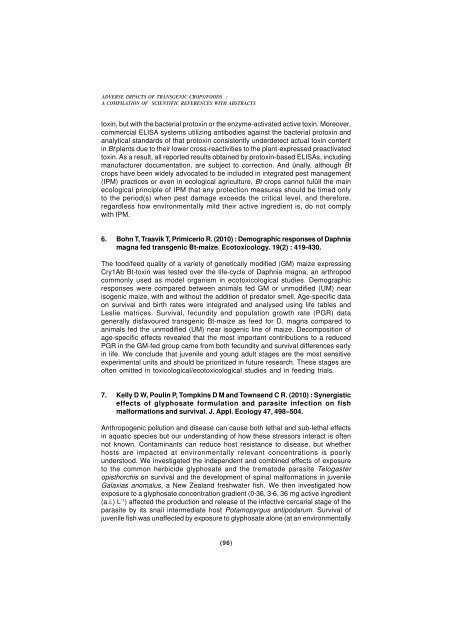omb3dyw
omb3dyw
omb3dyw
You also want an ePaper? Increase the reach of your titles
YUMPU automatically turns print PDFs into web optimized ePapers that Google loves.
ADVERSE IMPACTS OF TRANSGENIC CROPS/FOODS :A COMPILATION OF SCIENTIFIC REFERENCES WITH ABSTRACTStoxin, but with the bacterial protoxin or the enzyme-activated active toxin. Moreover,commercial ELISA systems utilizing antibodies against the bacterial protoxin andanalytical standards of that protoxin consistently underdetect actual toxin contentin Bt plants due to their lower cross-reactivities to the plant-expressed preactivatedtoxin. As a result, all reported results obtained by protoxin-based ELISAs, includingmanufacturer documentation, are subject to correction. And ûnally, although Btcrops have been widely advocated to be included in integrated pest management(IPM) practices or even in ecological agriculture, Bt crops cannot fulûll the mainecological principle of IPM that any protection measures should be timed onlyto the period(s) when pest damage exceeds the critical level, and therefore,regardless how environmentally mild their active ingredient is, do not complywith IPM.6. Bohn T, Traavik T, Primicerio R. (2010) : Demographic responses of Daphniamagna fed transgenic Bt-maize. Ecotoxicology. 19(2) : 419-430.The food/feed quality of a variety of genetically modified (GM) maize expressingCry1Ab Bt-toxin was tested over the life-cycle of Daphnia magna, an arthropodcommonly used as model organism in ecotoxicological studies. Demographicresponses were compared between animals fed GM or unmodified (UM) nearisogenic maize, with and without the addition of predator smell. Age-specific dataon survival and birth rates were integrated and analysed using life tables andLeslie matrices. Survival, fecundity and population growth rate (PGR) datagenerally disfavoured transgenic Bt-maize as feed for D. magna compared toanimals fed the unmodified (UM) near isogenic line of maize. Decomposition ofage-specific effects revealed that the most important contributions to a reducedPGR in the GM-fed group came from both fecundity and survival differences earlyin life. We conclude that juvenile and young adult stages are the most sensitiveexperimental units and should be prioritized in future research. These stages areoften omitted in toxicological/ecotoxicological studies and in feeding trials.7. Kelly D W, Poulin P, Tompkins D M and Townsend C R. (2010) : Synergisticeffects of glyphosate formulation and parasite infection on fishmalformations and survival. J. Appl. Ecology 47, 498–504.Anthropogenic pollution and disease can cause both lethal and sub-lethal effectsin aquatic species but our understanding of how these stressors interact is oftennot known. Contaminants can reduce host resistance to disease, but whetherhosts are impacted at environmentally relevant concentrations is poorlyunderstood. We investigated the independent and combined effects of exposureto the common herbicide glyphosate and the trematode parasite Telogasteropisthorchis on survival and the development of spinal malformations in juvenileGalaxias anomalus, a New Zealand freshwater fish. We then investigated howexposure to a glyphosate concentration gradient (0·36, 3·6, 36 mg active ingredient(a.i.) L ”1 ) affected the production and release of the infective cercarial stage of theparasite by its snail intermediate host Potamopyrgus antipodarum. Survival ofjuvenile fish was unaffected by exposure to glyphosate alone (at an environmentally(96)


